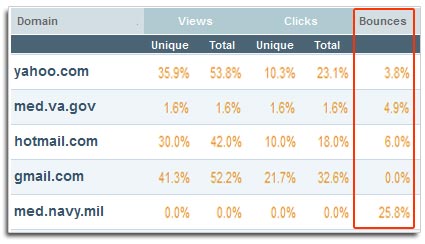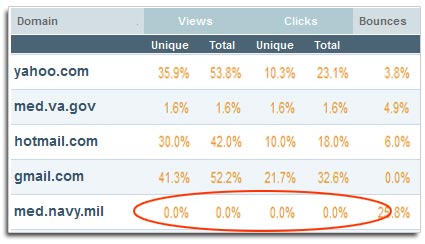Last week, a client asked me what I meant when I said some of her email marketing campaign "went missing." We were looking at the results from her recent email newsletter, specifically reviewing the domain-level results breakdown. I pointed out that there were two domains that had either zero or one view across the entire list. That's a pretty good sign that your email was missing or went to the Junk folder.
"Is that the same as a bounce?" She asked the same question so many email marketing pros ask when looking at the two side-by-side. While both bounces and "missing" affect your email deliverability — whether or not your email gets into the Inbox — they're not the same. Here's a quick review of the two and how to identify and handle each.
Bounces
There are two categories of bounces: hard bounces and soft bounces. A hard bounce means that email address doesn't exist. It could be a typo, like expert@emfluence,cmo or it could be something that looks like a real address, but just doesn't exist, like kittensandpuppies72847@yahoo.com. When you get a hard bounce from an email address, you should remove it from your email list. This person isn't there at all and you'll save money and save your sender reputation by taking them off. (Most email service providers will automatically remove hard bounces from your list for you to keep you from trying to email them again.)
There are over 500 kinds of soft bounces, ranging from an out of office reply to "server temporarily unavailable" to an overly full Inbox and hundreds more. These can mean all kinds of things, but are usually ok. You should still keep that person on your list for now, but it's probably worth monitoring those email addresses that keep soft bouncing every time you send an email campaign. Some email service providers will help you handle soft bounces, too. For example, the emfluence Marketing Platform assigns a "smart score" to soft bounces, where an out of office might only gets half a point and a server error gets a whole point. When an email address gains a score of 5 or higher without ever successfully getting to the recipient, you can pretty much bet that it's no good and can remove it from your email list.

Missing
The dirty little secret of email marketing: email providers like Gmail and Yahoo! don't have to deliver you email. And they don't have to tell you they didn't deliver it. When an email goes to the Junk or Spam folder, you don't get a notification. You simply hang out in the Junk folder. With some email clients, you don't even go to Junk, you go nowheres-ville and you don't usually get notification for that either.
That doesn't mean you can't tell when your email (probably) didn't make it to the Inbox, though. Just like with my client this week, we're looking for "goose eggs." After your email sends, when you review your results, take a look at your results by domain. If any of your recipient domains show significantly lower open or click through rates, or show zeroes all the way across your results chart, it's pretty likely you went to Junk or went missing. For example, if your open rate for an email was 20%, but your open rate for that email at Yahoo was only 5%, it's likely you have a problem.
If you partner with a deliverability specialist like Return Path or Pivotal Veracity, you can include a "seed list" when you deploy your email campaigns that can offer more insight. The seed list is a few hundred email addresses from all the most popular email clients (AOL, Gmail, Hotmail, Yahoo, Comcast) that help show you whether you landed in the Inbox, the Spam Folder or never showed up at all, a.k.a. Missing.
What do you do to fix or prevent going missing? It's all part of the art of deliverability. Some domains are particularly finicky, like *.earthlink, *.gov or *.mil email addresses. Yahoo can be harsh, too, erring on the side of keeping their Inbox users happy and keeping potential spam out. But there are ways to help you get through to the Inbox.
- Ask users to add your email address to their Safe Senders list. This can be worded any way you like, so feel free to put your personality into it.
- Keep bad addresses out of your list, like repeated soft bounces or long-time inactive email addresses. If a higher percent of your email list interacts with you, Yahoo and Gmail know you're probably not a spammer.
- Authenticate your marketing emails. Be sure your email service provider is an authorized sender of email from your email address & domain, via Domain Keys, SenderID & SPF validation techniques. If you're sending large volumes and seeing consistent sticking issues, you may consider white listing services like becoming Sender Score Certified through Return Path. If it means more Inboxes — and so, more eyeballs — it may be worth the fees. (There are a few options, mostly paid.)
Important point (to make it just a bit more complicated): some email clients actually do send you a bounce notification when they think you're spam. Comcast has been known to do this, for example. This is actually a big favor to you, because at least they're telling you that they think you're spam and you can fill out the correct forms to get un-blocked or to start getting through again.
Most of the time, though, bounces are more an indicator of how clean your list is rather than of your deliverability. They're forever intertwined, but to answer the client's initial question: they're not the same.





Thank you for the helpful information!!
Nice post, Jess! To complicate issues even further, of course, now many major ISPs are bringing engagement metrics into the mix.
Very interesting information. Thanks, Jessica. Emfluence always provides such helpful insights!
Thanks, David! Glad you found it so useful 🙂 Lynn, engagement metrics have long since been a factor in how you’re “judged” and whether you make it into the inbox. All the more reason to conduct re-engagement campaigns or consider trimming your long-time inactive contacts. Thanks for reading, all!